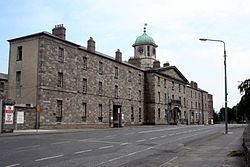Richmond General Penitentiary

This is the Richmond General Penitentiary as it exists today
|
|
| Location | Grangegorman, Dublin 7 |
|---|---|
| Coordinates | 53°21′16.97″N 6°16′41.22″W / 53.3547139°N 6.2781167°W |
| Status | Currently in use as the offices of the Grangegorman Development Agency (http://ggda.ie/) and DIT Campus Planning |
| Opened | 1820 |
| Closed | 1831 |
The Richmond General Penitentiary was a prison established in 1820 in Grangegorman, Dublin, Ireland as an alternative to transportation. It was part of an experiment into a penitentiary system which also involved Millbank Penitentiary, London. Richmond and Millbank penitentiaries were the first prisons in the United Kingdom of Great Britain and Ireland (as it was at the time) to specialise in reform rather than punishment. The building was designed by the architect Francis Johnston and decorated by George Stapleton. The building ceased to be a penitentiary in 1831, and later became part of the Richmond Asylum.
In 1810, the Governors of the House Industry situated on North Brunswick Street were instructed by the Lord Lieutenant of Ireland to purchase land for the construction of a penitentiary. The purpose of the penitentiary was to provide a custodial and rehabilitative alternative to the transportation of prisoners to Botany Bay, Australia. It was hoped that through solitary confinement, hard labour and religious instruction that prisoners might be reformed. They obtained a three half acre site from Lord Monck in Grangegorman which was at that time planted with apple and pear trees. Given that the Governors already had responsibility for the management of several prisons, including the Female penitentiary in Kilmainham, the House of Correction, Smithfield, the penitentiary in James's Street and a prison ward in the House of Industry, they were assigned the task of overseeing the building of the institution that would be known as the Richmond General Penitentiary. The architect appointed was Francis Johnston. The building was completed in 1816, but it served as a fever hospital in that year and was subsequently completely refurbished. It received its first prisoners in 1820.
...
Wikipedia
